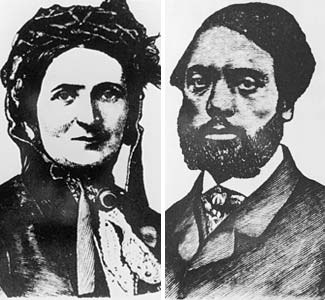 William and Ellen Craft’s daring escape from slavery in 1848 made them famous throughout antebellum America, heroes in the eyes of abolitionists and criminals in the eyes of slavery supporters. The unusual circumstances of their flight to freedom were a major factor in their celebrity. Ellen, so light-skinned as to be nearly white, disguised herself in men’s clothing and posed as a young white planter to effect her escape. Her husband, William, played the role of her slave. Together, they traveled from Georgia to Philadelphia by train and by boat, often staying in first-class accommodations and always directly under the noses of southern authorities. Americans everywhere were moved by their amazing story of boundary crossing, for the Crafts passed through not only the literal boundary that separated North from South, but also the social boundaries of race, class, and gender that divided the population of the United States.
William and Ellen Craft’s daring escape from slavery in 1848 made them famous throughout antebellum America, heroes in the eyes of abolitionists and criminals in the eyes of slavery supporters. The unusual circumstances of their flight to freedom were a major factor in their celebrity. Ellen, so light-skinned as to be nearly white, disguised herself in men’s clothing and posed as a young white planter to effect her escape. Her husband, William, played the role of her slave. Together, they traveled from Georgia to Philadelphia by train and by boat, often staying in first-class accommodations and always directly under the noses of southern authorities. Americans everywhere were moved by their amazing story of boundary crossing, for the Crafts passed through not only the literal boundary that separated North from South, but also the social boundaries of race, class, and gender that divided the population of the United States.
At an early age, both William and Ellen witnessed the break-up of their families as a result of their enslavement. William’s master sold his mother, father, brother, sister, and eventually William in order to pay off debts. Working for a variety of masters, William learned the craft of carpentry and labored in a cabinetmaker’s shop. Ellen, born in 1826, was the daughter of Major James Smith, a wealthy white plantation owner, and Maria, his mulatto house slave. Major Smith’s white wife, annoyed by the presence in her household of her husband’s natural daughter by a slave, gave Ellen to her own daughter, Eliza, as a wedding present. At the age of eleven, Ellen was thus separated from her mother and sent to live in Macon, Georgia, as the slave of her white half-sister.
William and Ellen met in Macon in the early 1840s and married in 1846 in a slave ceremony that was not recognized as legal or binding in the southern states. Fearing the possibility of sale or separation, they decided not to have children while they were still enslaved. Instead, they formulated their bold escape plan, purchasing clothing for Ellen’s disguise and asking their masters for a couple of days of vacation on the pretense of visiting friends and relatives. Since Ellen could not write (teaching slaves to read or write was a criminal offense in the South), she bound up her arm in a sling to discourage officials from asking her to sign documents. She also took the precaution of wearing a poultice on her face to disguise her femininity and to limit conversations with strangers. In this guise of a sickly white man accompanied by his slave, the couple took just four days to reach the North, where they were hidden by a Quaker family on a farm outside Philadelphia. A few weeks later, they moved on to the safer community of Boston.
In Boston, the Crafts were warmly received by abolitionists and by the free black community. They were invited to tour with noted abolitionist William Wells Brown, giving speeches and lectures on the nature and effects of slavery. Later, Brown would fictionalize their escape in one of the first African American novels, Clotel; or, The President’s Daughter (1853). Eventually, William Craft established himself as a cabinetmaker, and Ellen found work as a seamstress. Their comfortable life in Boston came to an abrupt end, however, with the passage of the Fugitive Slave Act of 1850. Mandating that escaped slaves residing in the North had to be returned to their masters in the South, the law jeopardized William and Ellen’s hard-earned freedom. When Ellen’s former owner dispatched two slave-catchers to Boston to capture and return the fugitives, the city rallied to the Crafts’ cause and drove the slave-catchers out of town. The incident left the Crafts feeling vulnerable, however, and they decided to immigrate to England where they could find safety and asylum.
In England, William and Ellen continued their work lecturing and speaking, profoundly influencing British attitudes toward slavery in the process. They also attended the Ockham school, an agricultural academy in Surrey, where they built on the education they had begun to acquire in Philadelphia and in Boston. While in England, the Crafts had four children and established themselves in business. Between 1862 and 1865, William planned and executed a series of journeys to Dahomey, Africa, to teach Christianity and agriculture to the Africans there, as well as to promote trade. The scheme was not entirely successful, leaving the Crafts deeply in debt.
Unemployed and in financial straits, the Crafts decided to return to the United States in 1869, after the conclusion of the Civil War. They purchased Hickory Hill, a plantation in Savannah, Georgia, hoping to run it as a cooperative managed by freed blacks. Reconstruction-era Georgia proved to be a hostile environment for their idealistic project; a band of angry whites burned down the plantation in 1870, entirely destroying the house, barn, and first planted crop. Still committed to their vision, the Crafts refused to give up. In 1871, they took a lease on Woodville, a plantation outside of Savannah in a county where the majority of the population was black, and opened a school and cooperative farm there. Though they never again had to contend with the kind of overt violence they had encountered at Hickory Hill, they were dogged by perpetual hostility, discrimination, and debt for the remainder of their lives.
Today William and Ellen Craft are remembered primarily for their extraordinary escape from slavery and for William’s gripping narrative of that escape. Published in 1860 in England, Running a Thousand Miles for Freedom was an immediate hit, going through two editions in two years. The narrative offers important testimony about the harshness of slavery, while also challenging common antebellum notions of race, class, and gender.
Source: http://www.learner.org/amerpass/unit07/authors-3.html
